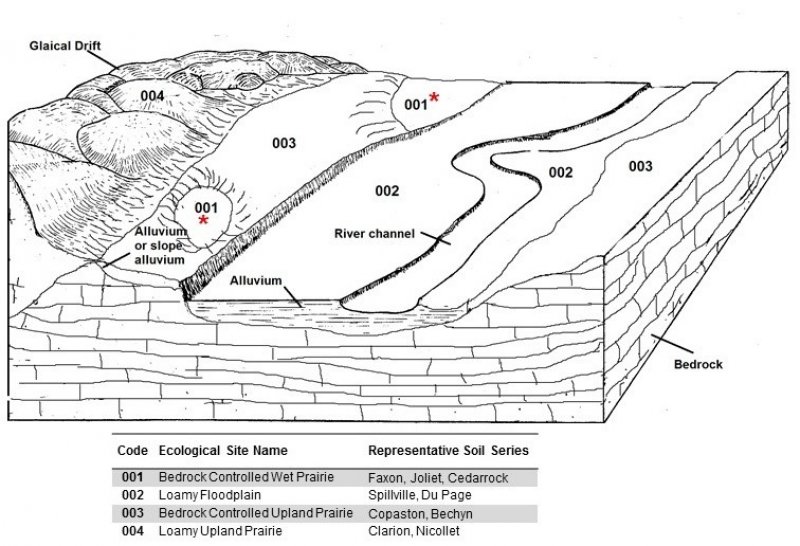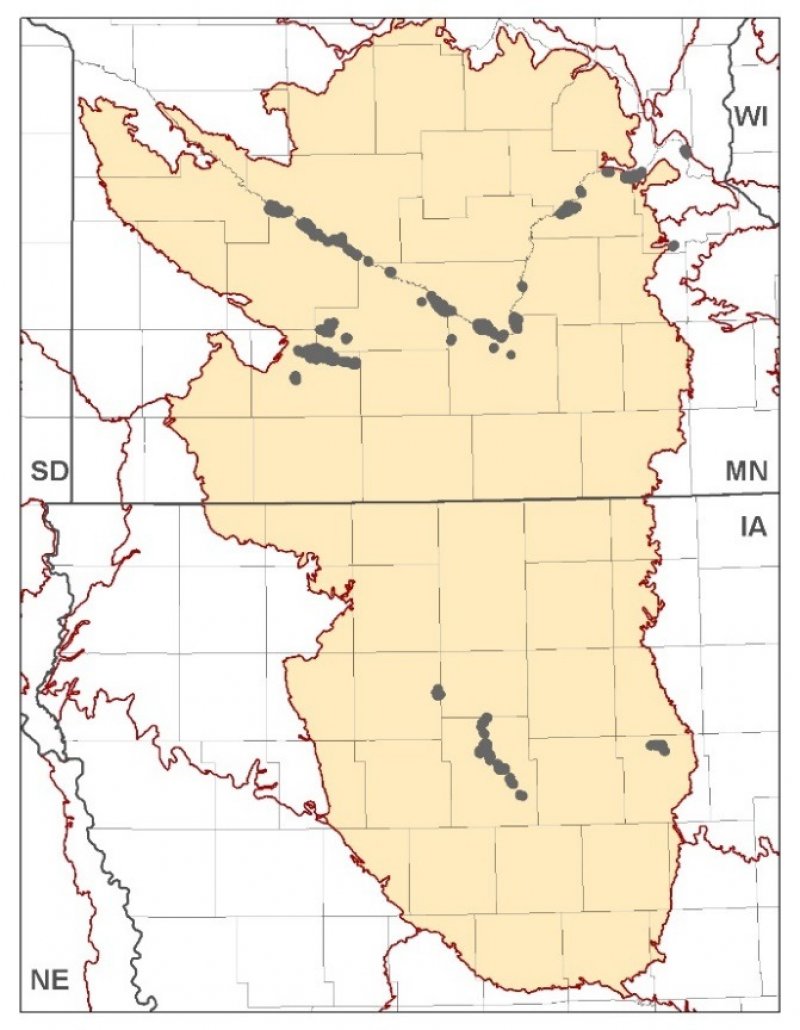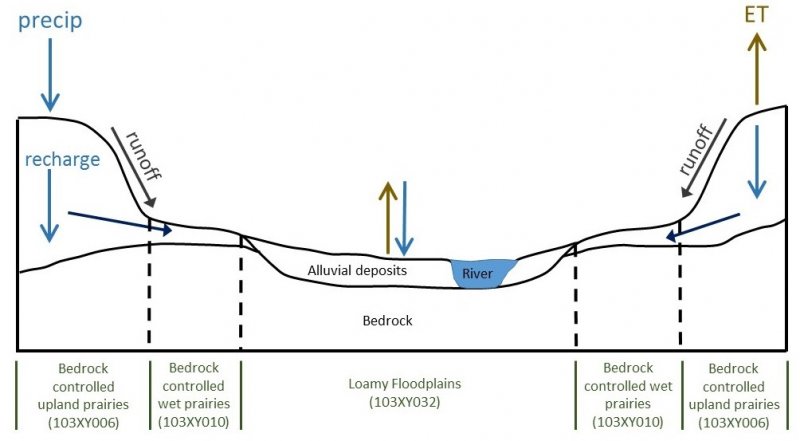Ecological dynamics
The Bedrock Controlled Wet Prairies ecological site is characterized by three states: the Reference State, the Tillage State, and the Woodland State. Although the Tillage State is described in this model, this does not imply that all areas of this site are suitable for tillage. Some soils in this group are shallow (less than 20" in depth) and not well suited for intensive crop production. Two grassland communities exist in the Reference State and are characterized by different fire return intervals. Grazing can also be a trigger for change on this ecological site. The Tillage State describes sites that have been tilled and generally have modified hydrology (ditching, tiling). Some areas of this ecological site are in a Woodland State. Without fire or grazing to control woody vegetation, this site will eventually revert to a woodland. These sites often are impacted by unmanaged grazing and non-native vegetation.
State 1
Reference State
The Bedrock Controlled Wet Prairies reference state is a wet-tolerant native tallgrass prairie. Even though these sites are on poorly drained soils, plants adapted to these sites must also be tolerant of dry conditions for a portion of the growing season. Community phases within the Reference State are dependent upon the frequency of fire or influence of grazing. The secondary trigger for conversion is grazing.
Today, high-quality, unplowed areas are extremely uncommon. Most remaining natural areas that are managed for tallgrass prairie were once tilled and utilized for agricultural production. It is therefore likely that many of the historic native prairie species are extirpated even from these sites.
Resilience management. Prescribed fire and managed grazing are key resilience management practices. Prescribed grazing incorporates periods of grazing rest during the growing season which benefits tallgrass maintenance.
Community 1.1
High Diversity Prairie
This plant community consists of native grasses and forbs. The vegetative composition is influenced primarily by a fire return intervals of less than 3 years. Fire reduces woody species, stimulates seed regeneration, and reduces the amount of thatch. Common grass species include big bluestem, prairie cordgrass, indiangrass, and multiple species of sedges. The composition of forb species is often highly diverse. A suite of diagnostic forbs is yet to be developed; however, common species include goldenrod and asters.
Resilience management. Prescribed fire and managed grazing are key resilience management practices. This is a stable plant community when grazing and fire are adequately managed.
Prescribed grazing incorporates periods of grazing rest during the growing season which benefits tallgrass maintenance. Excessive grazing can quickly impact the vegetative composition and negatively impact soil stability.
Prescribed fire is the controlled application of fire to modify vegetation structure and influence ecological processes.
Community 1.2
Old Growth Prairie
This plant community is characterized by a fire return interval of 3 to 5 years, which is longer than that of Community 1.1. Grass species are dominant, but more woody species are present. Thatch and dead plant residue are dense and begins to reduce seedling regeneration by shading and obstruction.
Resilience management. Prescribed fire and grazing are resilience management practices. Although this community has a longer fire return interval than Community 1.1, it also relies on fire and grazing to maintain vegetation community structure.
Pathway 1.1A
Community 1.1 to 1.2
Fire is the primary trigger that affects grassland community composition. This pathway consists of a fire free period of 3 to 5 years. Other triggers can be grazing and drought.
Pathway 1.2A
Community 1.2 to 1.1
This pathway consists of a fire return interval of less than 3 years. Fire intolerant woody species are set back, and the amount of dead plant material is reduced.
State 2
Tillage State
Tillage is the primary mechanism affecting the transition to this state. Hydrological modifications (tiling and ditching) may be installed to improve drainage. Not all areas within this ecological site are suitable for intensive row crop production due to shallow soils (10-20" to bedrock). Undrained areas also have a seasonal high water table with can limit agricultural uses. Tillage alters dynamic soil properties such as bulk density, structure, organic carbon content, and saturated hydraulic conductivity. Most areas in this state will remain in use for crop production in the foreseeable future.
Conservation practices can mitigate the impacts of traditional agricultural practices on soil health. Conservation tillage minimizes soil disturbance and can improve soil structure and overall soil health. Corn or soybean plantings and a cover crop rotation can build soil structure, improve infiltration rates, reduce runoff and erosion, and protect water quality.
A small percentage of this ecological sites have been seeded back to grass. Some previously tilled areas have been converted to warm-season grasslands as part of a NRCS conservation program. Species seeded will depend upon the hydrology of the site and landowners' objectives. Cool-season grasses are also feasible. Species often include reed canarygrass and Kentucky bluegrass. Although cool-season grasslands are not as diverse as warm-season grasslands, they still offer benefits to soil health and wildlife.
Some previously tilled and farmed sites may revert to a woodland through abandonment; however, this is a small percentage of acres within MLRA 103 so is not currently a community in this model.
Resilience management. Disturbance management and harvest management are resilience management practices. The maintenance of this state requires that the intensity, frequency, duration, and timing of agricultural practices (disturbances) be managed to control or modify vegetation structure.
Community 2.1
Row Crop Community
This plant community typically consists of intensively produced, traditional row crops. Tillage and intentional plant establishment (crop seeding) are the primary triggers for this community. A secondary trigger is substantial hydrological modifications (ditching and tiling), which are commonly installed to improve soil drainage. The most common crops are corn and soybeans on an annual rotation.
Resilience management. Disturbance management and harvest management are resilience management practices. The maintenance of the desired vegetation community requires management of the intensity, frequency, duration, and timing of disturbances caused by agricultural practices.
Community 2.2
Seeded Grassland Community
This community is in areas that were previously tilled and used for agricultural production but have been transitioned to either warm-season or cool-season grasses. The primary trigger is the intentional establishment of a grassland community.
Resilience management. Disturbance management and harvest management are resilience management practices. The maintenance of the desired vegetation structure requires management of the intensity, frequency, duration, and timing of disturbances caused by agricultural practices. Practices include seeding, controlling weeds and brush, and applying fertilizer. Practices include seeding, controlling weeds and brush, and fertilizing.
Prescribed fire is a resilience management practice on warm-season grasslands. The controlled application of fire modifies vegetation structure and influence ecological processes.
Pathway 2.1.A
Community 2.1 to 2.2
This pathway converts Community 2.1 (row crops) to Community 2.2 (seeded grassland).
The primary mechanism of change is the seeding of desired grass species. Warm-season grasses are often established through a conservation program such as the NRCS Conservation Reserve Program.
| Forage and Biomass Planting |
|
Pathway 2.2.A
Community 2.2 to 2.1
This pathway converts seeded grassland to cropland. This is a common pathway throughout MLRA 103 as areas are placed in crop production. The mechanisms of change are tillage and intentional plant establishment (crop seeding). Resilience management practices include weed control (herbicide application), field cultivation, fertilizer application, and harvest management.
State 3
Woodland State
In the absence of a natural fire regime, grazing, or management inputs, this site will transition to a wooded state. Often, other disturbances such as unmanaged grazing, altered hydrology, and invasive species impact these areas. Community composition and characteristics will vary depending on the type, severity, and length of disturbances. Trees on site often include boxelder, green ash, willow, and cottonwood. Reed canarygrass, Kentucky bluegrass, smooth brome, and other non-native cool-season grasses often invade open areas.
Community 3.1
Woodland Community
This site is a scrubby woodland plant community usually consisting of various species of trees, shrubs, and often, non-native species. Common trees include eastern cottonwood, willows, green ash, and boxelder. Open areas may be dominated by reed canarygrass and Kentucky bluegrass. Weed species, such as great ragweed (Ambrosia trifida L.) and stinging nettle (Urtica dioica L.), are often present. Plant community composition will be determined by disturbances, management inputs, and seed sources.
Transition T1A
State 1 to 2
Transition T1A is the conversion of the reference state to agriculture. The triggers are tillage and intentional plant establishment (crop seeding). Hydrological modifications, such as ditching and tiling, are often also installed.
Not all areas in the Bedrock Controlled Wet Prairies ecological site are suitable for tillage and intensive agriculture. Limiting factors are shallow soils (10-20" to bedrock) and a seasonal high water table.
Constraints to recovery. Tillage and long-term intensive agricultural production generally preclude a return to State 1. Areas in row crop production may be placed in conservation programs and seeded with warm-season grasses, but will not exhibit the natural species diversity or ecological resiliency of State 1.
Some tilled areas may be abandoned and return to woodland, but this is a small percentage of acres and not currently given a community in this model. Most acres converted to agriculture will stay as such for the foreseeable future.
Transition T1B
State 1 to 3
Plant community succession via the lack of natural fire and/or grazing. Brush and trees will increase and plant community structure will begin to move from a prairie to a woodland. Disturbances such as overgrazing and non-native vegetation may influence the plant community composition and structure.
Restoration pathway R3A
State 3 to 1
Sites that have not been tilled and still have natural hydrologic functions may be feasible to restore back to a reference community. Soil structure is intact and remnant plant communities may still exist on site.
Previously tilled sites (State 2) may revert to a woodland through abandonment; however, the soil function has been altered through tillage, drainage, and intensive crop production. This site will not be the same ecologically as a true reference site.



